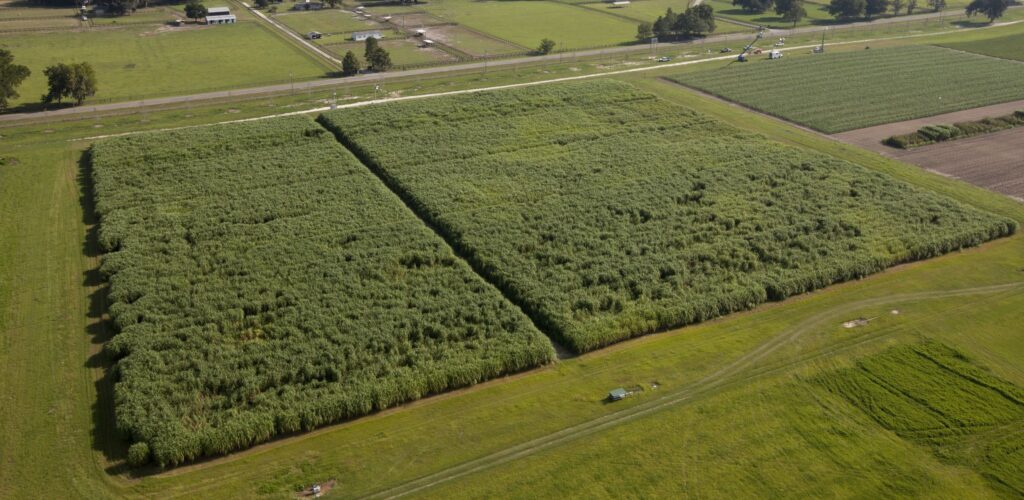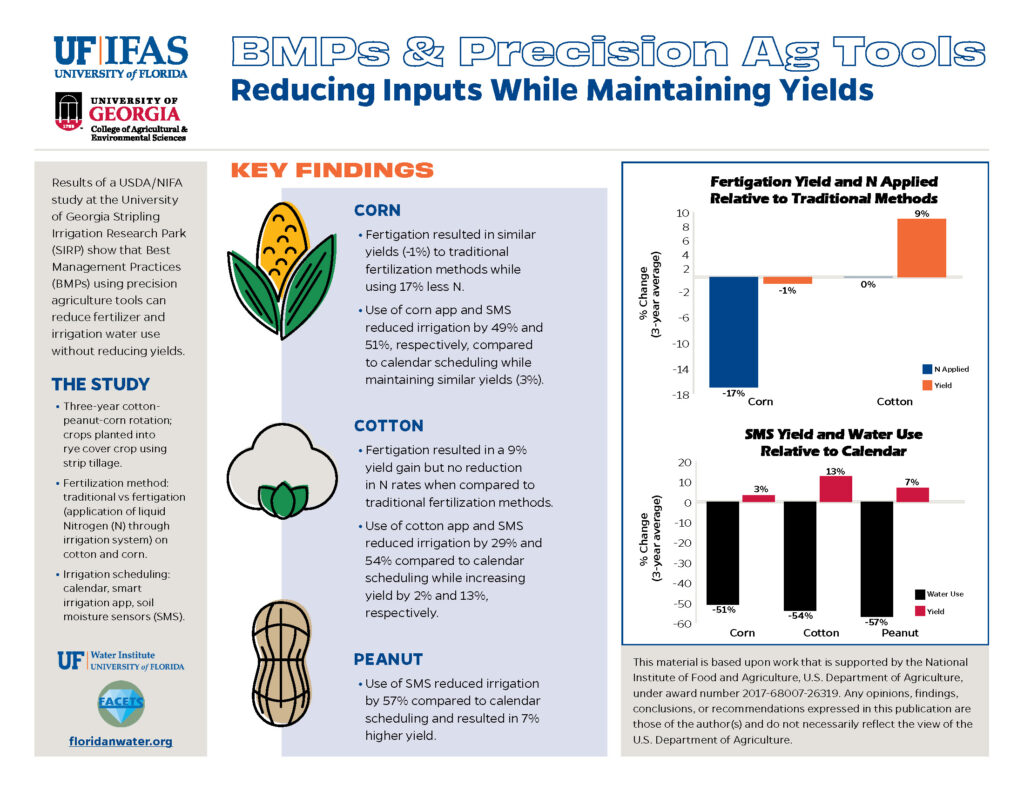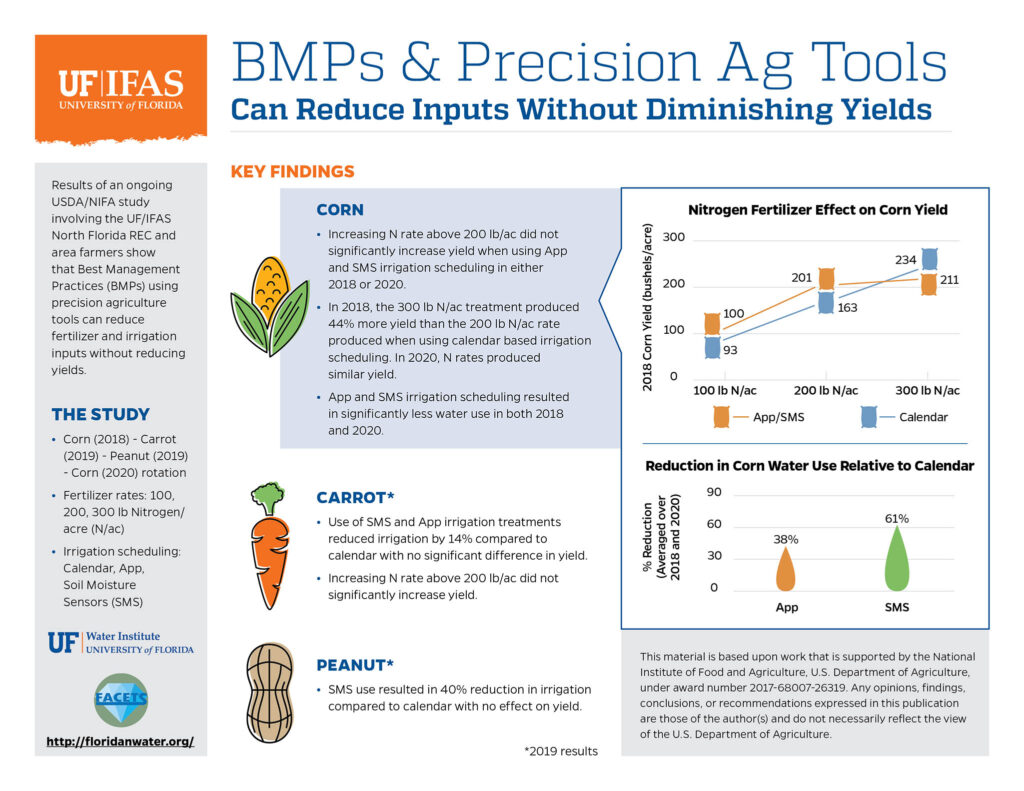
The goal of the field research was to demonstrate promising new cropping systems and BMPs that had not been previously demonstrated or widely adopted by stakeholders. This research quantified crop yield, water savings and nutrient loss across a range of irrigation, nutrient management, and cover crop practices.
Results from the BMP research informed Biophysical and Economic Farm/Forest-Scale Modeling, the development of the Digital Decision Toolkit and the Extension programming.
BMP research in Florida was conducted at the University of Florida’s Suwannee Valley Agricultural Extension Center. The experiment had 120 20’x40’ plots arranged in a randomized complete block design with 4 replications across 4 irrigation scheduling alternatives and 3 nitrogen fertilizer rate treatments for a corn (2018) -carrot (2019)-peanut (2019)-corn (2020) rotation.
Key findings: This research showed that use of irrigation apps and soil moisture sensors (SMS) reduced irrigation relative to calendar scheduling by 38-61% in corn, 14% in carrot, and 40% in peanut. Results also showed that N rates above 200 ld/ac do not significantly increase yield for corn or carrot when using apps and SMS to schedule irrigation.
View PDF
Publications
- Acharya, B., Sharma, V., Barrett, C., Sidhu, S. S., Zotarelli, L., & Dukes, M. D. (2023). Methods to quantify in-field nutrient leaching: AE581/AE581, 12/2022. EDIS 2022(6). https://doi.org/10.32473/edis-ae581-2022
- Diamond, J. (2019). Development and Assessment of a Smartphone Application for Evapotranspiration Based Irrigation Scheduling of Field Corn [Unpublished master’s thesis]. University of Florida. https://ufdc.ufl.edu/UFE0054391/00001
- Lee, D., Merrick, J., Rath, S., Dukes, M., Kaplan, D., & Graham, W. (2024). Groundwater impacts of adding carrot to corn-peanut rotations in North Florida. Agricultural Water Management, 294. https://doi.org/10.1016/j.agwat.2024.108713
- Merrick, J. & Dukes, M. (2021). BMPs & precision ag tools can reduce inputs without diminishing yields in Florida [Infographics].
- Morrow, M., Sharma, V., Hochmuth, R., Barrett, C., & Burani-Arouca, M. (2023). Carrot (Daucus carota) Production in the Sandy Soils of North Florida: Nitrogen Fertilization Guidelines : AE588/AE588, 7/2023. EDIS, 2023(4). https://doi.org/10.32473/edis-ae588-2023
- Zamora Re, M. (2019). Irrigation and nitrogen best management practices in corn production [Unpublished doctoral dissertation]. Department of Agricultural and Biological Engineering, University of Florida. https://ufdc.ufl.edu/UFE0053946/00001/pdf
- Zamora-Re, M. I., Dukes, M. D., Hensley, D., Rowland D., & Graham, W. (2020). The effect of irrigation strategies and nitrogen fertilizer rates on maize growth and grain yield. Irrigation Science, 38, 461-478. https://doi.org/10.1007/s00271-020-00687-y
- Zamora-Re, M., I., Merrick, R. J., & Dukes, M., D. (2021). Floridan Aquifer Collaborative Engagement for Sustainability (FACETS) – field trial data from Live Oak, Florida. [Data set]. Ag Data Commons. https://doi.org/10.15482/USDA.ADC/1521079
Meet the Team
Michael Dukes, University of Florida
Justice Diamond, University of Florida
Jason Merrick, University of Florida
Maria Zamora, University of Florida
BMP research in Georgia was conducted at the University of Georgia Stripling Irrigation Research Park (SIRP). The experimental design consisted of 81 48’x48’ plots where different irrigation and fertilization treatments for a corn-cotton-peanut rotation were evaluated. Corn and cotton had 3 nitrogen fertilization and 3 irrigation treatments, while peanut had 9 irrigation treatments only. Each treatment had three replicates.
Key findings: GA BMP research showed that the use of SMS can reduce irrigation by 50-60% compared to calendar scheduling. In GA fertigation produced similar yields to traditional fertilization while using 17% less N.

View PDF
Publications
- Aryan, F. (2023). Comparing biophysical models of corn-cotton-peanut field experiment [Unpublished master’s thesis]. University of Florida. https://original-ufdc.uflib.ufl.edu/UFE0060422/00001
- Sangster, S. (2022). Assessing the feasibility of fertigation on cotton (29992430) [Master’s thesis, University of Georgia]. ProQuest Dissertations & Theses Global. https://esploro.libs.uga.edu/esploro/outputs/graduate/Assessing-the-Feasibility-of-Fertigation-on/9949515823502959
- Tadych, D. (2020). Investigating soil parameters effect on crop yields and hydrology at field scale in the southeast US using the soil and water assessment tool (30272775) [Master’s thesis, Crop Soils and Environmental Sciences Department, Auburn University]. AProQuest Dissertations & Theses Global. https://www.proquest.com/docview/2779137005?sourcetype=Dissertations%20&%20Theses
- Toffanin, A. (2019). Predicting precision nitrogen side-dress applications for maize with a simulation model (27546406) [Master’s thesis, Crop and Soil Science, University of Georgia]. ProQuest Dissertations & Theses Global. https://esploro.libs.uga.edu/esploro/outputs/9949365748502959
- Vellidis, G. (2022a). BMPs & precision ag tools in GA: reducing inputs while maintaining yields [Infographics].
- Vellidis, G. (2022b). Floridan Aquifer Collaborative Engagement for Sustainability (FACETS) – field trial data from University of Georgia Stripling Irrigation Research Park (SIRP). [Data set]. Ag Data Commons. https://doi.org/10.15482/USDA.ADC/1527816
Meet the Team
George Vellidis, University of Georgia
Shelby Sangster, University of Georgia
Arianna Toffanin, University of Georgia


